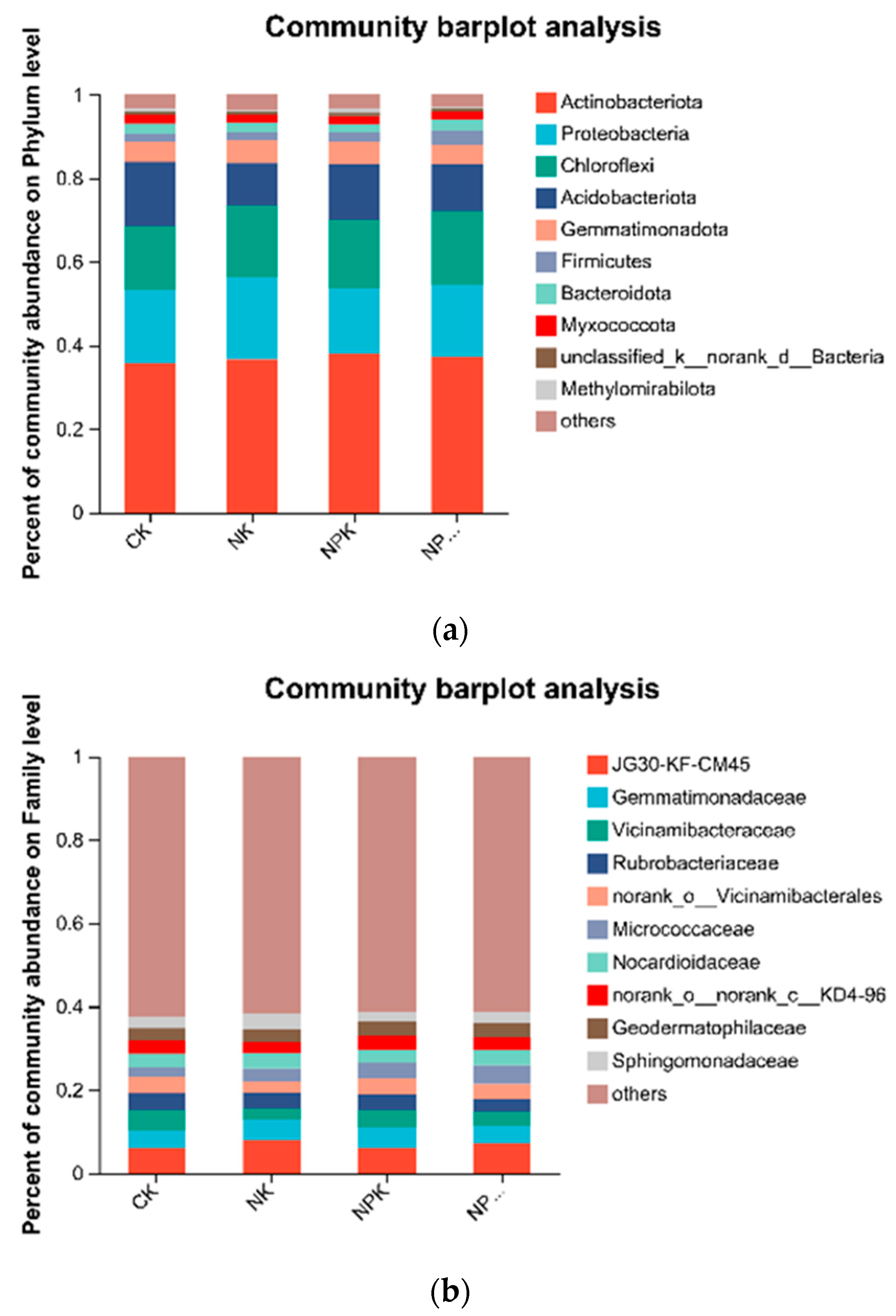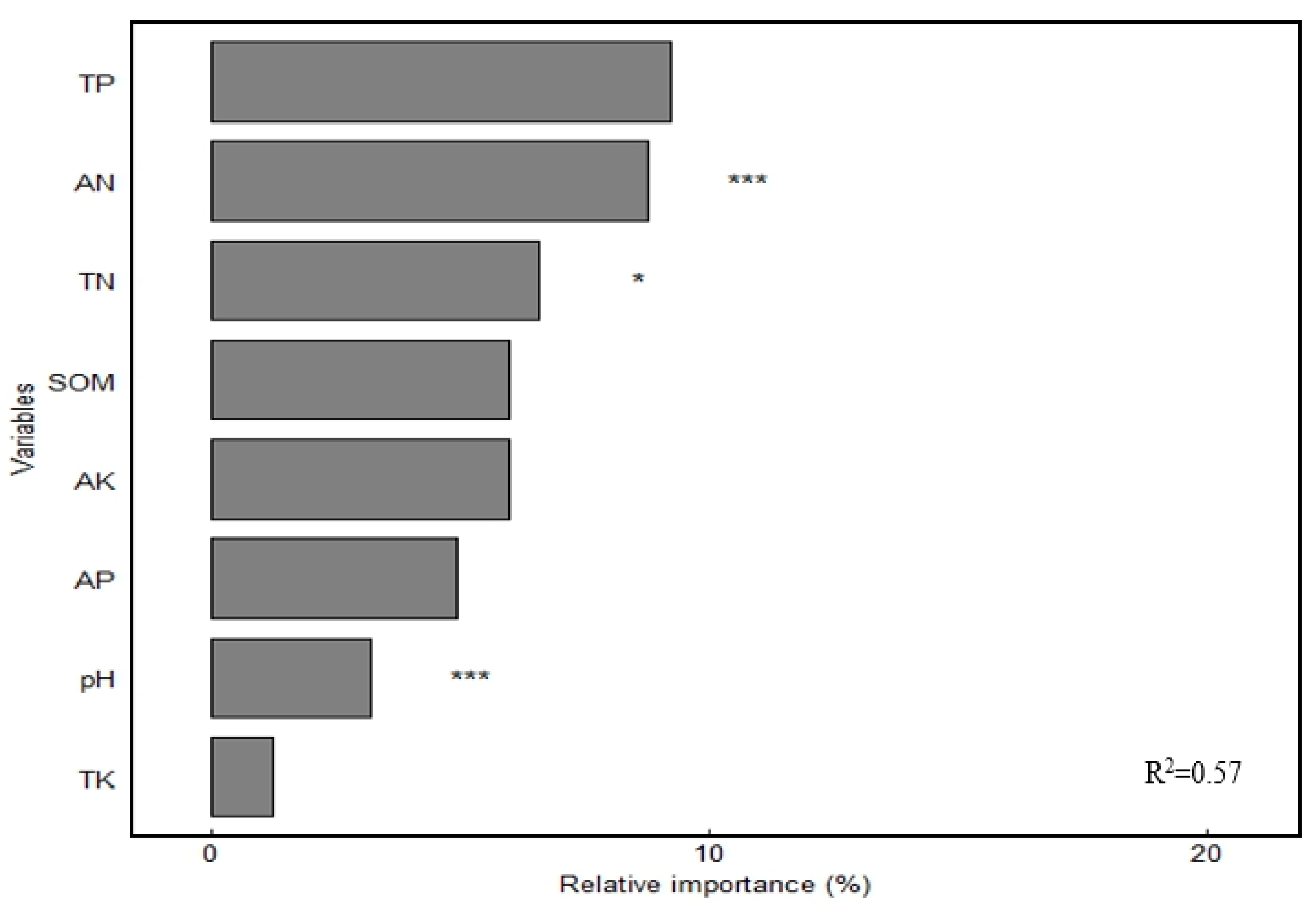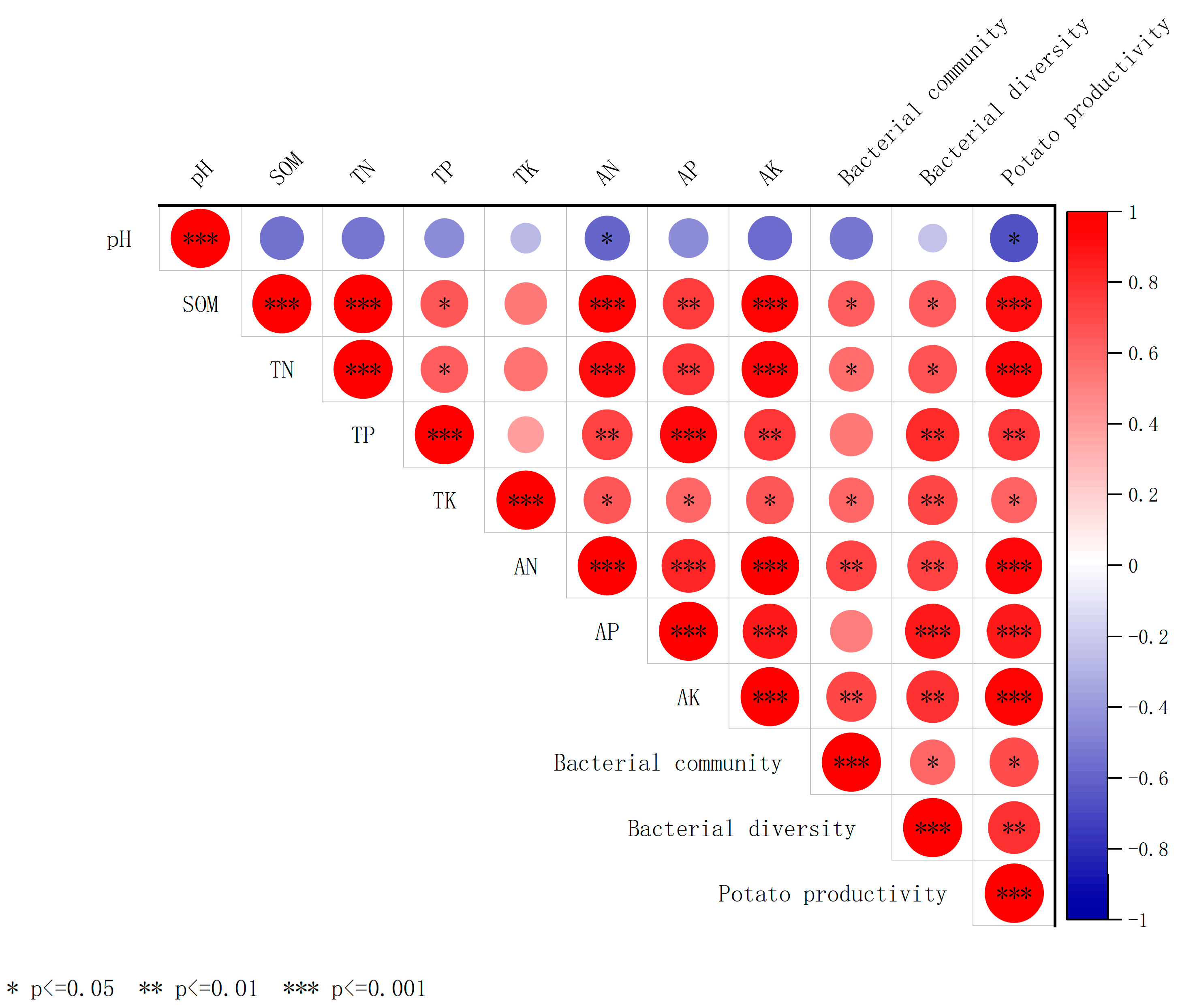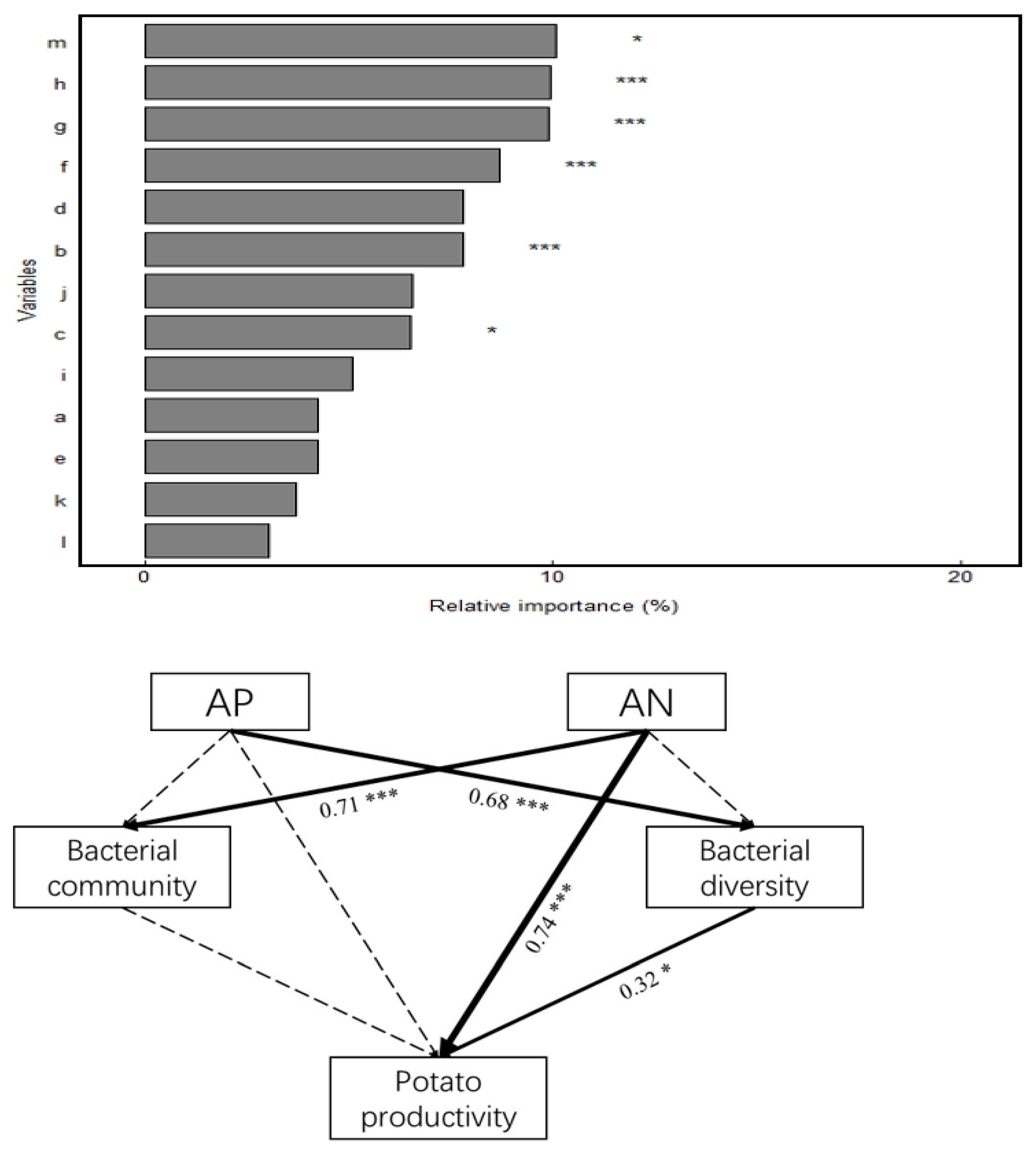Response of Soil Bacterial Communities and Potato Productivity to Fertilizer Application in Farmlands in the Agropastoral Zone of Northern China
Abstract
:1. Introduction
2. Materials and Methods
2.1. Overview of the Study Area
2.2. Experimental Design
2.3. Sample Collection
2.4. Determination Items and Methods
2.4.1. Determination of the Physical and Chemical Properties of Soil
2.4.2. DNA Extraction and PCR Amplification of the Soil Samples
- (1)
- DNA extraction
- (2)
- Amplicon sequencing
- (3)
- Bioinformatic Analysis
2.5. Statistical Analysis
3. Results and Analyses
3.1. Soil Properties and Potato Productivity under Different Fertilizer Treatments
3.2. Characteristics of Soil Bacterial Community under Different Fertilizer Treatments
3.3. Relationships among Soil Chemical Properties, Bacterial Communities, and Potato Productivity
4. Discussion
5. Conclusions
Author Contributions
Funding
Data Availability Statement
Conflicts of Interest
References
- Dang, H.; Rong, L.; Li, Y.; Zhao, M. Spatiotemporal evolution characteristics and influencing factors of production-living-ecological spaces in the farming-pastoral ecotone: Taking Hohhot of Inner Mongolia as an example. Arid Zone Res. 2023, 40, 1698–1706. [Google Scholar]
- Pan, Y.; Tang, H.; Fang, F.; Ma, Y.; Chen, Z. Is elemental stoichiometry (C, N, P) of soil and soil microbial biomass influenced by management modes and soil depth in the agro-pastoral transitional zone of northern China? J. Soils Sediments 2023, 23, 32–48. [Google Scholar] [CrossRef]
- Bai, Y.C.; Chang, Y.Y.; Hussain, M.; Lu, B.; Zhang, J.P.; Song, X.B.; Lei, X.S.; Pei, D. Soil Chemical and Microbiological Properties Are Changed by Long-Term Chemical Fertilizers That Limit Ecosystem Functioning. Microorganisms 2020, 8, 694. [Google Scholar] [CrossRef] [PubMed]
- Tang, Q.; Cotton, A.; Wei, Z.; Xia, Y.; Daniell, T.; Yan, X. How does partial substitution of chemical fertilizer with organic forms increase sustainability of agricultural production? Sci. Total Environ. 2022, 803, 149933. [Google Scholar] [CrossRef] [PubMed]
- Goyer, C.; Neupane, S.; Zebarth, B.J.; Burton, D.L.; Wilson, C.; Sennett, L. Diverse compost products influence soil bacterial and fungal community diversity in potato crop production systems. Appl. Soil Ecol. 2022, 169, 104247. [Google Scholar] [CrossRef]
- Upadhyay, S.K.; Rajput, V.D.; Kumari, A.; Espinosa-Saiz, D.; Menendez, E.; Minkina, T.; Dwivedi, P.; Mandzhieva, S. Plant growth-promoting rhizobacteria: A potential bio-asset for the restoration of degraded soil and crop productivity using sustainable emerging techniques. Environ. Geochem. Health 2023, 45, 9321–9344. [Google Scholar] [CrossRef]
- Shi, G.; Sun, H.; Calderón-Urrea, A.; Li, M.; Yang, H.; Wang, W.; Su, G. Bacterial communities as indicators of soil health in a continuous crop** system. Land Degrad. Dev. 2021, 32, 2393–2408. [Google Scholar] [CrossRef]
- Wu, L.; Jiang, Y.; Zhao, F.; He, X.; Liu, H.; Yu, K. Increased organic fertilizer application and reduced chemical fertilizer application affect the soil properties and bacterial communities of grape rhizosphere soil. Sci. Rep. 2020, 10, 9568. [Google Scholar] [CrossRef]
- Liu, J.; Shu, A.; Song, W.; Shi, W.; Li, M.; Zhang, W.; Li, Z.; Liu, G.; Yuan, F.; Zhang, S.; et al. Long-term organic fertilizer substitution increases rice yield by improving soil properties and regulating soil bacteria. Geoderma 2021, 404, 115287. [Google Scholar] [CrossRef]
- Jia, L.I.U.; Chen, X.F.; Li, W.T.; Jiang, C.Y.; Meng, W.U.; Ming Li, U.; Li, Z.P. Bacterial diversity and community composition changes in paddy soils with different parent materials and fertility levels. J. Integr. Agric. 2021, 20, 2797–2806. [Google Scholar]
- Gupta, A.; Singh, U.B.; Sahu, P.K.; Paul, S.; Kumar, A.; Malviya, D.; Singh, S.; Kuppusamy, P.; Singh, P.; Paul, D.; et al. Linking soil microbial diversity to modern agricultural practices: A review. Int. J. Environ. Res. Public Health 2022, 19, 3141. [Google Scholar] [CrossRef] [PubMed]
- Dincă, L.C.; Grenni, P.; Onet, C.; Onet, A. Fertilization and soil microbial communities: A review. Appl. Sci. 2022, 12, 1198. [Google Scholar] [CrossRef]
- Han, J.; Dong, Y.; Zhang, M. Chemical fertilizer reduction with organic fertilizer effectively improves soil fertility and microbial community in newly cultivated land on the Loess Plateau of China. Appl. Soil Ecol. 2021, 165, 103966. [Google Scholar] [CrossRef]
- Bao, S.D. Soil and Agrochemical Analysis, 3rd ed.; China Agriculture Press: Beijing, China, 2000. [Google Scholar]
- Edgar, R.C. UPARSE: Highly accurate OTU sequences from microbial amplicon reads. Nat. Methods 2013, 10, 996. [Google Scholar] [CrossRef] [PubMed]
- Callahan, B.J.; Mcmurdie, P.J.; Rosen, M.J.; Han, A.W.; Johnson, A.J.A.; Holmes, S.P. DADA2: High-resolution sample inference from Illumina amplicon data. Nat. Methods 2016, 13, 581–583. [Google Scholar] [CrossRef] [PubMed]
- Bolyen, E.; Rideout, J.R.; Dillon, M.R.; Bokulich, N.A.; Abnet, C.C.; Al-Ghalith, G.A.; Alexander, H.; Alm, E.J.; Arumugam, M.; Asnicar, F.; et al. Reproducible, interactive, scalable and extensible microbiome data science using QIIME 2. Nat. Biotechnol. 2019, 37, 852–857. [Google Scholar] [CrossRef] [PubMed]
- Quast, C.; Pruesse, E.; Yilmaz, P.; Gerken, J.; Schweer, T.; Yarza, P.; Peplies, J.; Glöckner, F.O. The SILVA ribosomal RNA gene database project: Improved data processing and web-based tools. Nucleic Acids Res. 2012, 41, D590–D596. [Google Scholar] [CrossRef]
- Segata, N.; Izard, J.; Waldron, L.; Gevers, D.; Miropolsky, L.; Garrett, W.S.; Huttenhower, C. Metagenomic biomarker discovery and explanation. Genome Biol. 2011, 12, R60. [Google Scholar] [CrossRef] [PubMed]
- Oyetunji, O.; Bolan, N.; Hancock, G. A comprehensive review on enhancing nutrient use efficiency and productivity of broadacre (arable) crops with the combined use of compost and fertilizers. J. Environ. Manag. 2022, 317, 115395. [Google Scholar] [CrossRef]
- Jia, X.; Wang, Y.; Zhang, Q.; Lin, S.; Zhang, Y.; Du, M.; Chen, M.; Ye, J.; Wu, Z.; Wang, H. Reasonable deep application of sheep manure fertilizer to alleviate soil acidification and improve tea yield and quality. Front. Plant Sci. 2023, 14, 1179960. [Google Scholar] [CrossRef]
- Lal, B.; Sharma, S.C.; Meena, R.L.; Sarkar, S.; Sahoo, A.; Balai, R.C.; Gautam, P.; Meena, B.P. Use of byproducts of sheep farming as organic fertilizer for improving soil health and productivity of barley forage. J. Environ. Manag. 2020, 269, 110765. [Google Scholar] [CrossRef]
- Yang, Q.; Zheng, F.; Jia, X.; Liu, P.; Dong, S.; Zhang, J.; Zhao, B. The combined application of organic and inorganic fertilizers increases soil organic matter and improves the soil microenvironment in wheat-maize fields. J. Soils Sediments 2020, 20, 2395–2404. [Google Scholar] [CrossRef]
- Esilaba, A.O. KCEP-CRAL Integrated Soil Fertility and Water Management Extension Manual; Kenya Agricultural and Livestock Research Organization: Nairobi, Kenya, 2021. [Google Scholar]
- Xu, T.; Yi, S.; Zhou, Y.; Li, Q.; Liu, Y. Temporal and Spatial Changes and Driving Forces of Soil Properties in Subtropical Mountainous Areas from 2017 to 2020: A Case Study of Baokang County, Hubei Province, China. Land 2022, 11, 1735. [Google Scholar] [CrossRef]
- Li, X.; Li, B.; Chen, L.; Liang, J.; Huang, R.; Tang, X.; Zhang, X.; Wang, C. Partial substitution of chemical fertilizer with organic fertilizer over seven years increases yields and restores soil bacterial community diversity in wheat–rice rotation. Eur. J. Agron. 2022, 133, 126445. [Google Scholar] [CrossRef]
- Vairavan, C.; Thiyageshwari, S.; Malarvizhi, P.; Saraswathi, T.; Teli, K.G.; Pugazenthi, K. Impact of tnau-water soluble fertilizers (tnau-wsf) on soil nutrient availability, nutrient content and bulb quality of small onion (allium cepa var. aggregatum). Int. J. Plant Soil Sci. 2023, 35, 446–454. [Google Scholar] [CrossRef]
- Verma, B.C.; Pramanik, P.; Bhaduri, D. Organic fertilizers for sustainable soil and environmental management. In Nutrient Dynamics for Sustainable Crop Production; Springer: Singapore, 2020. [Google Scholar]
- Kc, B.; Pandey, B.; Chand, H.; Bhusal, P.; Pandit, S.; Khanal, S. Promotion of organic and sustainable agriculture through the use of bio-fertilizers. J. Wastes Biomass Manag. 2020, 3, 1–8. [Google Scholar]
- Ma, L.; Zhang, J.; Li, Z.; Xin, X.; Guo, Z.; Wang, D.; Li, D.; Zhao, B. Long-term phosphorus deficiency decreased bacterial-fungal network complexity and efficiency across three soil types in china as revealed by network analysis. Appl. Soil Ecol. 2020, 148, 103506. [Google Scholar] [CrossRef]
- Jiang, H.; Li, S.; Wang, T.; Chi, X.; Qi, P.; Chen, G. Interaction between halotolerant phosphate-solubilizing bacteria (Providencia rettgeri Strain TPM23) and rock phosphate improves soil biochemical properties and peanut growth in saline soil. Front. Microbiol. 2021, 12, 777351. [Google Scholar]
- Wei, X.; Zhu, Z.; Liu, Y.; Luo, Y.; Deng, Y.; Xu, X.; Ge, T. C:N:P stoichiometry regulates soil organic carbon mineralization and concomitant shifts in microbial community composition in paddy soil. Biol. Fertil. Soils 2020, 56, 1093–1107. [Google Scholar] [CrossRef]
- Li, S.; Wang, Z.; Hu, T.; Gao, Y.; Stewart, B. Nitrogen in dryland soils of China and its management. Adv. Agron. 2009, 101, 123–181. [Google Scholar]
- Wang, X.; Feng, J.; Ao, G.; Qin, W.; Han, M.; Shen, Y.; Liu, M.; Chen, Y.; Zhu, B. Globally nitrogen addition alters soil microbial community structure, but has minor effects on soil microbial diversity and richness. Soil Biol. Biochem. 2023, 179, 108982. [Google Scholar] [CrossRef]








| Treatment | N | P2O5 | K2O | M |
|---|---|---|---|---|
| CK | 0 | 0 | 0 | 0 |
| NK | 150 | 0 | 75 | 0 |
| NPK | 150 | 45 | 75 | 0 |
| NPKM | 150 | 45 | 75 | 15,000 |
| Treatment | pH | SOM g/kg | TN g/kg | TP g/kg | TK g/kg | AN mg/kg | AP mg/kg | AK mg/kg | Potato Productivity t/hm2 |
|---|---|---|---|---|---|---|---|---|---|
| CK | 8.3 ± 0.1 a | 6.0 ± 0.6 c | 0.79 ± 0.04 c | 0.13 ± 0.04 c | 17.8 ± 1.6 b | 57.10 ± 2.08 d | 7.2 ± 1.0 c | 65.1 ± 7.0 c | 8.0 ± 0.8 d |
| NK | 7.9 ± 0.4 b | 23.8 ± 1.8 b | 0.59 ± 0.08 d | 0.08 ± 0.03 c | 22.8 ± 2.6 a | 84.09 ± 4.74 c | 7.5 ± 0.7 c | 108.1 ± 13.9 b | 11.8 ± 1.1 c |
| NPK | 7.8 ± 0.4 b | 25.1 ± 1.1 b | 1.31 ± 0.06 b | 0.45 ± 0.07 b | 23.8 ± 2.0 a | 95.47 ± 6.32 b | 17.9 ± 1.9 b | 132.5 ± 7.4 b | 15.1 ± 1.4 b |
| NPKM | 7.6 ± 0.4 b | 32.4 ± 1.0 a | 1.51 ± 0.07 a | 0.59 ± 0.02 a | 24.1 ± 1.6 a | 124.6 ± 3.5 a | 26.1 ± 2.7 a | 209.7 ± 20.3 a | 18.1 ± 2.0 a |
| Treatment | Sobs | Shannon | Ace | Chao1 |
|---|---|---|---|---|
| CK | 2475 ± 74 b | 6.4 ± 0.1 b | 3352 ± 120 b | 3304 ± 84 b |
| NK | 2476 ± 74 b | 6.4 ± 0.1 b | 3337 ± 50 b | 3351 ± 45 b |
| NPK | 2621 ± 88 ab | 6.5 ± 0.1 ab | 3565 ± 84 a | 3545 ± 75 a |
| NPKM | 2696 ± 80 a | 6.6 ± 0.1 a | 3526 ± 86 a | 3524 ± 62 a |
Disclaimer/Publisher’s Note: The statements, opinions and data contained in all publications are solely those of the individual author(s) and contributor(s) and not of MDPI and/or the editor(s). MDPI and/or the editor(s) disclaim responsibility for any injury to people or property resulting from any ideas, methods, instructions or products referred to in the content. |
© 2024 by the authors. Licensee MDPI, Basel, Switzerland. This article is an open access article distributed under the terms and conditions of the Creative Commons Attribution (CC BY) license (https://creativecommons.org/licenses/by/4.0/).
Share and Cite
Liang, J.; Shi, X.; Zhang, T.; An, H.; Hou, J.; Lan, H.; Zhao, P.; Hou, D.; Zhang, S.; Zhang, J. Response of Soil Bacterial Communities and Potato Productivity to Fertilizer Application in Farmlands in the Agropastoral Zone of Northern China. Agronomy 2024, 14, 1432. https://doi.org/10.3390/agronomy14071432
Liang J, Shi X, Zhang T, An H, Hou J, Lan H, Zhao P, Hou D, Zhang S, Zhang J. Response of Soil Bacterial Communities and Potato Productivity to Fertilizer Application in Farmlands in the Agropastoral Zone of Northern China. Agronomy. 2024; 14(7):1432. https://doi.org/10.3390/agronomy14071432
Chicago/Turabian StyleLiang, Junmei, Xiaohua Shi, Tingting Zhang, Hao An, Jianwei Hou, Huiqing Lan, Peiyi Zhao, Dingyi Hou, Sheng Zhang, and Jun Zhang. 2024. "Response of Soil Bacterial Communities and Potato Productivity to Fertilizer Application in Farmlands in the Agropastoral Zone of Northern China" Agronomy 14, no. 7: 1432. https://doi.org/10.3390/agronomy14071432




